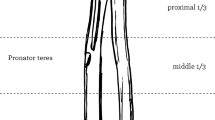Summary
A series of 200 consecutive junctional middle-distal third tibial shaft fractures caused by indirect violence was analysed with emphasis on the significance of the location of the fibular reciprocal fracture. The fibular fracture was eccentric, i.e. subcapital or malleolar, in 96 patients. This fracture pattern was encountered only in adults and showed significantly more severe initial displacement and with conservative treatment longer union time than fractures with intact fibula or the fibular fracture on the same level with the tibial fracture.
Especially for fractures with an initial lateral displacement of more than one half of the diaphyseal diameter and with an eccentric fibular reciprocal fracture internal fixation with uncomplicated postoperative course shortened the union time and prevented residual deformity. A malleolar fibular fracture and the rare separate displaced posterior triangle fracture should in addition as such be regarded as indications for osteosynthesis.
Zusammenfassung
Bei 200 Patienten mit einem Unterschenkelschaftbruch, verursacht durch ein indirektes Trauma, wurde die Frakturmorphologie analysiert. Bei 96 Patienten war die Fibulafraktur exzentrisch, nämlich subkapital oder malleolär. Dieses Frakturmuster wies signifikant häufiger eine starke primäre Seitendislokation mit schwerer Instabilität auf. Außerdem bestand unter konservativer Behandlung eine längere Konsolidierungszeit als bei diaphysären Tibiafrakturen mit intakter Fibula oder mit Fibulafraktur auf gleicher Höhe.
Bei diaphysären Tibiafrakturen mit einer primären Seitenverschiebung um mehr als halbe Schaftbreite und mit einer exzentrischen reziproken Fibulafraktur verkürzte die operative Behandlung (in den meisten Fällen eine Schrauben- oder Plattenosteosynthese nach den Prinzipien der AO) die Konsolidierungszeit, unter der Voraussetzung eines komplikationslosen Verlaufs. Ferner verhindert die Osteosynthese Residualdeformitäten. Eine Außenknöchelfraktur und das seltene Volkmannsche Dreieck müssen als selbständige Indikationen zur Osteosynthese betrachtet werden.
Similar content being viewed by others
References
Austin RT (1977) Fractures of the tibial shaft: is medical audit possible? Injury 9:93–101
Currey JD (1970) The mechanical properties of bone. Clin Orthop 73:210–231
Hansen BA, Greiff J, Bergmann F (1976) Fractures of the tibia in children. Acta Orthop Scand 47:448–453
Hooper G, Buxton RA (1981) Isolated fractures of the shaft of the tibia. Injury 12:283–287
Karlström G, Olerud S (1974) Fractures of the tibial shaft. A critical evaluation of treatment alternatives. Clin Orthop 105:82–115
Larsson K, van der Linden W (1981) Creatine kinase in tibial shaft fractures. Arch Orthop Traumat Surg 98:41–43
Martens M, Van Audekercke R, De Meester P, Mulier MC (1981) The geometrical properties of human femur and tibia and their importance for the mechanical behaviour of these bone structures. Arch Orthop Traumat Surg 98:113–120
Müller ME, Allgöwer M, Schneider R, Willenegger H (1977) Manual der Osteosynthese, 2. Aufl. Springer, Berlin Heidelberg New York
Pinder IM (1973) Refracture of the shaft of the adult tibia. J Bone Jt Surg 55-B:878
Rokkanen P, Slätis P (1972) Subcortical cancellous bone grafting in the treatment of delayed union of tibial shaft fractures. J Trauma 12:1075–1082
Sakellarides HT, Freeman PA, Grant BD (1964) Delayed union and non-union of tibial-shaft fractures. A review of 100 cases. J Bone Jt Surg 46-A:557–569
Schatzker J (1974) Compression in the surgical treatment of fractures of the tibia. Clin Orthop 105:220–239
Schweiberer L, Schenk R (1977) Histomorphologie und Vaskularisation der sekundären Knochenbruchheilung, unter besonderer Berücksichtigung der Tibiaschaftfraktur. Unfallheilkunde 80:275–286
Teitz CC, Carter DR, Frankel VH (1980) Problems associated with tibial fractures with intact fibulae. J Bone Jt Surg 62-A:770–776
Van der Linden W, Larsson K (1979) Plate fixation versus conservative treatment of tibial shaft fractures. J Bone Jt Surg 61-A:873–878
Weber BG (1972) Die Verletzungen des oberen Sprunggelenkes, 2. Aufl. Huber, Bern Stuttgart Wien
Weissman SL, Herold HZ, Engelberg M (1966) Fractures of the middle two-thirds of the tibial shaft. Results of treatment without internal fixation in one hundred and forty consecutive cases. J Bone Jt Surg 48-A:257–267
Woersdoerfer O, Weber BG (1981) Diaphyseal fractures of both bones of the lower leg with associated injury to the ankle mortise. Arch Orthop Traumat Surg 98:293–296
Author information
Authors and Affiliations
Rights and permissions
About this article
Cite this article
Böstman, O., Hänninen, A. The fibular reciprocal fracture in tibial shaft fractures caused by indirect violence. Arch. Orth. Traum. Surg. 100, 115–121 (1982). https://doi.org/10.1007/BF00462348
Received:
Accepted:
Issue Date:
DOI: https://doi.org/10.1007/BF00462348




